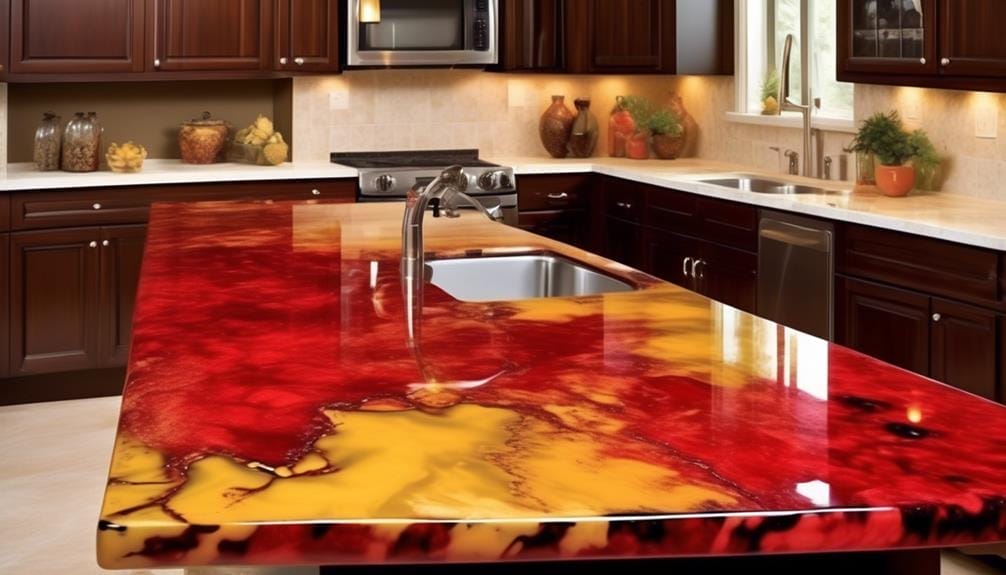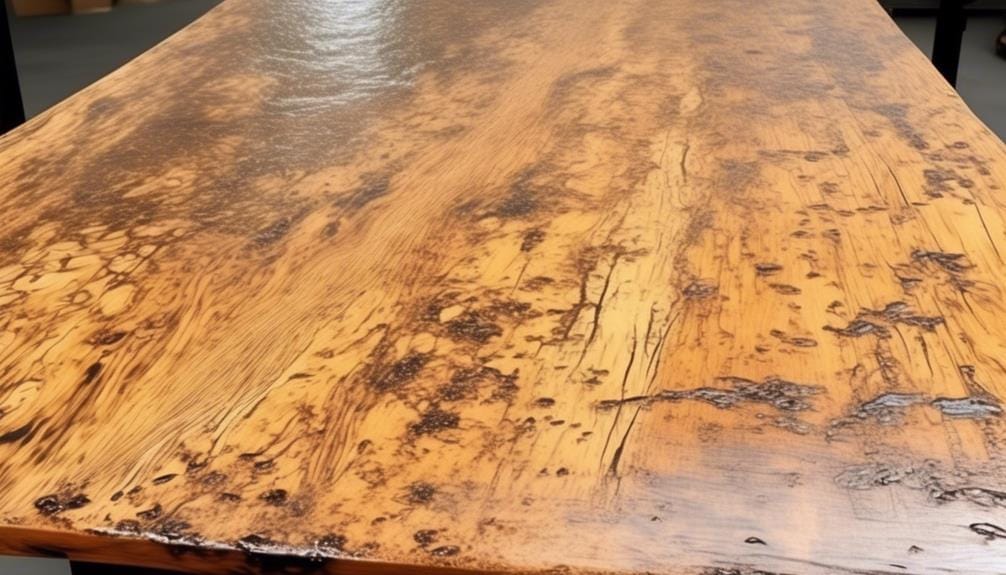Did you know that Liquid Glass Epoxy is becoming increasingly popular for its durability and stunning finish? With its high-gloss and mirror-like appearance, it's no wonder why many homeowners are choosing this epoxy for their tables.
However, to ensure that your Liquid Glass Epoxy table stays in pristine condition, it's important to follow some maintenance tips. Whether you're a proud owner or considering getting one, this discussion will provide you with essential information on how to properly care for your Liquid Glass Epoxy table.
From cleaning techniques to preventing scratches and protecting against stains, we will cover it all. So, let's dive into the world of Liquid Glass Epoxy maintenance and discover the secrets to keeping your table looking beautiful for years to come.
Key Takeaways
- Regularly clean the epoxy surface with mild soap and water to remove dust and debris.
- Use hot soapy water and a sponge for thorough cleaning, avoiding abrasive materials.
- Address small chips or scratches promptly by filling them with epoxy resin and scraping off excess.
- Protect the table from heat damage by using heat-resistant pads and avoiding direct contact with hot items.
Cleaning Techniques
To maintain the cleanliness and longevity of your epoxy resin table, follow these precise cleaning techniques.
Keeping the surface clean and dry is crucial for preserving its beauty and durability. Start by wiping down the table with a soft sponge and a damp towel. This will remove any dust or lint that may have accumulated.
For more thorough cleaning, use hot soapy water and a sponge, making sure to avoid abrasive materials like scratchy steel pads that can damage the surface. Isopropyl Alcohol can be used to remove stubborn stains, but be sure to test it on a small, inconspicuous area first.
After cleaning, dry the table thoroughly with a clean, lint-free cloth to prevent water spots. Proper care and maintenance are essential for protecting the epoxy resin table. Regular cleaning with soap and water is recommended, and applying a coat of mineral oil from time to time will help maintain its shine.
Lastly, consider using a conversion varnish finish for a smooth glossy surface and added protection.
Preventing Scratches
To prevent scratches on your epoxy resin table, handle it with caution and avoid dropping heavy items or using knives directly on the surface. Scratches can mar the smooth and glossy finish of the epoxy, detracting from its aesthetic appeal.
Here are three important steps to ensure the proper care and maintenance of your epoxy resin table:
- Clean the surface regularly: Dust and debris can act as abrasives, causing scratches when moved across the surface. Use a soft, non-abrasive cloth or sponge to gently wipe away any dirt or particles. Avoid using harsh chemicals or abrasive cleaners, as they can damage the epoxy coating.
- Sand out minor scratches: If you notice any shallow scratches on the surface, you can try sanding them out using fine-grit sandpaper. Start with a grit of around 400 and gradually work your way up to a finer grit, such as 800 or 1000, until the scratches are no longer visible. Remember to sand in a circular motion and be careful not to apply too much pressure.
- Apply a protective coat: To prevent future scratches and maintain the integrity of the epoxy surface, consider applying a protective coat. This will act as a barrier between the table and potential sources of damage. Ensure that you follow the manufacturer's instructions carefully when applying the coat to achieve the best results.
Protecting Against Stains

Protecting your epoxy resin table against stains requires proactive measures and careful consideration of its usage and environment.
To ensure the longevity of your epoxy resin surface, it's important to apply a seal coat before pouring the deep pour epoxy. This seal coat acts as a protective layer, guarding against potential stains and spills.
In addition to applying a seal coat, it's crucial to clean any spills or stains immediately to prevent them from penetrating the epoxy resin surface. Use a soft cloth or sponge with mild soap and water to gently wipe away any spills. For tougher stains, you can lightly sand the affected area with a fine-grit sandpaper and then clean it with isopropyl alcohol.
To prevent air bubbles from forming during the epoxy pouring process, use a heat gun or torch to carefully remove any trapped air. This step won't only help prevent bubbles but also ensure a smooth and flawless surface.
To protect your epoxy resin table from heat damage, always use a heat-resistant pad underneath hot dishes, pans, or pots. Placing hot objects directly on the table can cause the epoxy surface to warp or discolor.
Furthermore, it's important to shield your table from excessive sun exposure and UV damage. Use shade or umbrellas to protect the table, especially if it's placed outdoors. Excessive exposure to sunlight can cause the epoxy resin surface to yellow or degrade over time.
Regular Inspections
Perform regular inspections of your epoxy resin table to ensure its integrity and identify any potential issues. Regular inspections are crucial to maintaining the quality and longevity of your liquid glass epoxy surface. Here are three important reasons why regular inspections should be a part of your maintenance routine:
- Prevent water damage: Check the table's coating for any chips or cracks that could allow water to seep in. Water damage can compromise the structural integrity of the table and lead to costly repairs or replacements.
- Secure hardware: Inspect the hardware, such as screws and bolts, to ensure they're secure and free from rust. Loose or rusted hardware can affect the stability of the table and potentially cause accidents or damage.
- Assess base material: Consider that the base material of your table may not be coated with waterproof epoxy resin. Inspecting the base material regularly allows you to identify any signs of damage or wear that may require additional attention or protection.
During your inspection, if you notice any visible marks or marring on the surface of the table, use acetone to clean and remove them. For small chips or scratches, clean the area, fill it with epoxy resin, and carefully scrape off any excess.
Regular inspections, along with timely repairs and maintenance, will help ensure that your epoxy resin table remains in top condition for years to come.
Dealing With Wear and Tear

Regular inspections of your epoxy resin table not only help maintain its integrity and identify potential issues, but they also play a crucial role in addressing wear and tear on the surface. By conducting regular inspections, you can identify and address any chips, scratches, or dents that may arise from heavy items or sharp objects. To maintain the smooth finish of the surface, it is important to clean it using a soft sponge and hot soapy water, avoiding abrasive materials that could cause further damage. Additionally, protecting the table from excessive heat exposure is vital to prevent any potential damage. Using heat-resistant materials and hot pads for dishes can help safeguard the surface. Shielding the table from prolonged sunlight exposure with shade or umbrellas is also recommended. If you notice any small chips or scratches, it is important to address them promptly. Clean the affected area, fill it with epoxy resin, and scrape off any excess to prevent further damage. By following these maintenance tips, you can ensure the longevity of your epoxy resin table and keep it looking its best.
| Maintenance Tips |
|---|
| Inspect the surface regularly for chips, scratches, or dents caused by heavy items or sharp objects. |
| Clean the surface using a soft sponge and hot soapy water, avoiding abrasive materials. |
| Protect the table from excessive heat exposure using heat-resistant materials and hot pads for dishes. |
| Shield the table from prolonged sunlight exposure using shade or umbrellas. |
| Address small chips or scratches promptly by cleaning, filling with epoxy resin, and scraping off excess. |
Professional Maintenance Tips
To properly maintain your epoxy resin table and ensure its longevity, it's essential to follow professional maintenance tips. Here are three key tips to keep your table's surface clean and in optimal condition:
- Regular Cleaning: Clean the epoxy surface regularly using a mild soap and water solution. This will help remove any dirt, grime, or stains that may accumulate over time. Gently wipe the surface with a soft cloth or sponge, ensuring that you don't use abrasive cleaners or scrubbers, as they can scratch the epoxy finish.
- Protection from UV Rays: Epoxy resin tables, especially those made with liquid glass or deep pour epoxy, are susceptible to damage from prolonged exposure to sunlight. To prevent discoloration and degradation of the epoxy, it's crucial to protect the table from excessive sun exposure. Consider using shade or umbrellas to create a barrier between the table and harmful UV rays.
- Proper Handling: Take precautions to protect the epoxy surface from potential damage. Always use a hot pad or trivet underneath hot dishes, pans, or pots to prevent heat damage. Avoid dropping heavy objects onto the table and be cautious when moving or placing items with sharp metal edges to prevent dents, chips, and scratches.
Frequently Asked Questions
How Long Does It Take for Liquid Glass Epoxy to Cure?
Liquid glass epoxy typically cures within 48-72 hours. Factors like temperature and humidity can influence curing time. To accelerate curing, use a heat source or add accelerators. Test cure before handling and ensure proper ventilation during the process.
Can You Sand Liquid Glass Epoxy Resin?
Yes, you can sand liquid glass epoxy resin. Sanding techniques vary depending on the desired finish. Start with low-grit sandpaper and progress to higher grit for a polished result. Always wear a mask and work in a well-ventilated area for safety.
Is Liquid Glass Deep Pour Epoxy Food Safe?
Liquid Glass Deep Pour Epoxy is food safe, allowing you to confidently use it for various applications. Its low viscosity formulation ensures a bubble-free and crystal clear finish, while its durability and UV resistance make it ideal for DIY projects.
What Temperature Should Liquid Glass Deep Pour Epoxy Be?
To achieve ideal curing conditions, it's crucial to consider the effects of temperature on epoxy curing. Choose the right temperature for deep pour epoxy to avoid common temperature-related issues. Control temperature during pouring and explore variations in the curing process for desired finishes.
Conclusion
Congratulations! You've mastered the art of maintaining your Liquid Glass Epoxy table. With regular cleaning, protection from the elements, and careful handling, your table will remain in impeccable condition.
But let's be honest, who wants a perfect table anyway? Embrace the imperfections, the wear and tear that give it character.
After all, life is messy, and so should your table be. So, go ahead, enjoy your beautifully flawed Liquid Glass Epoxy table.





